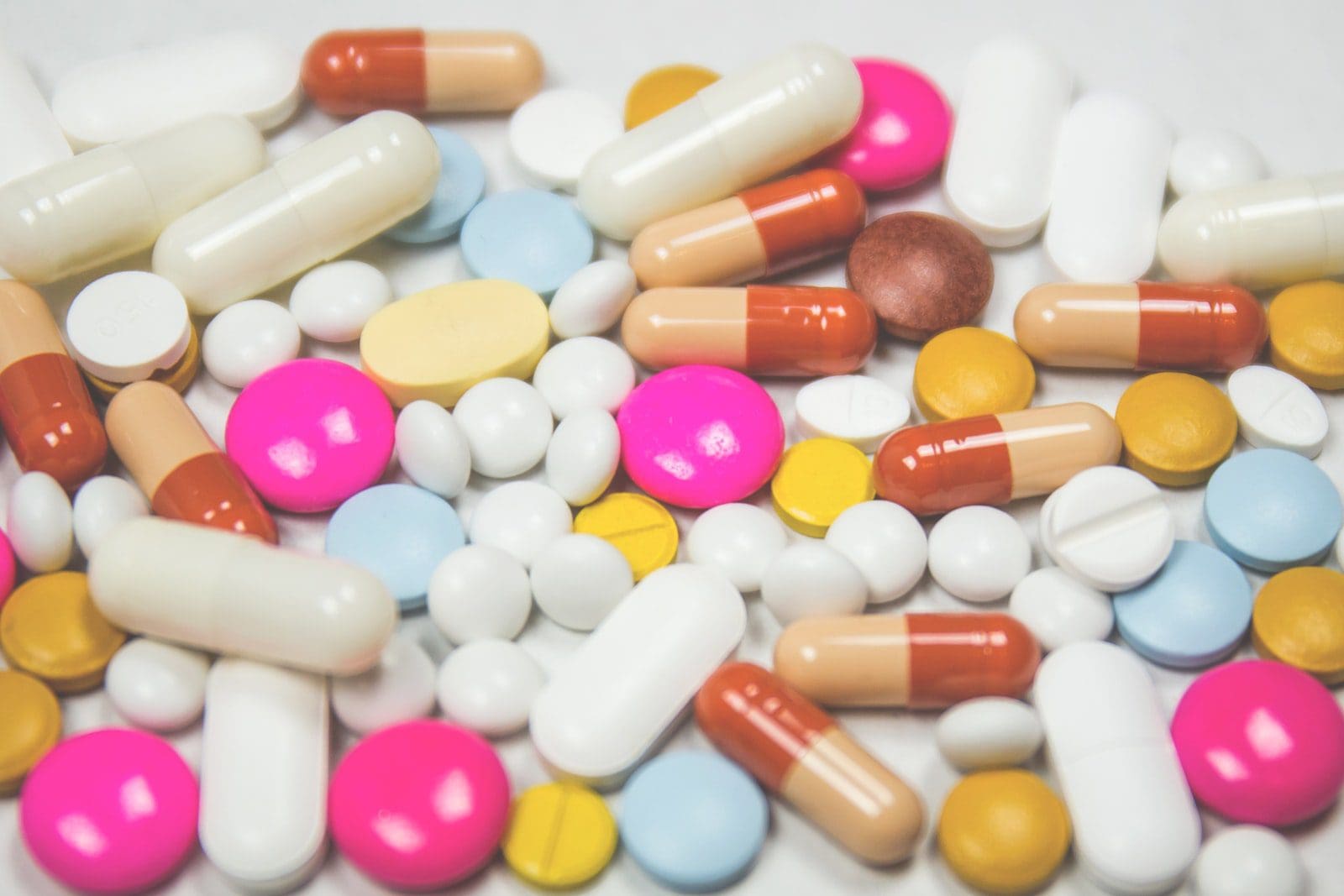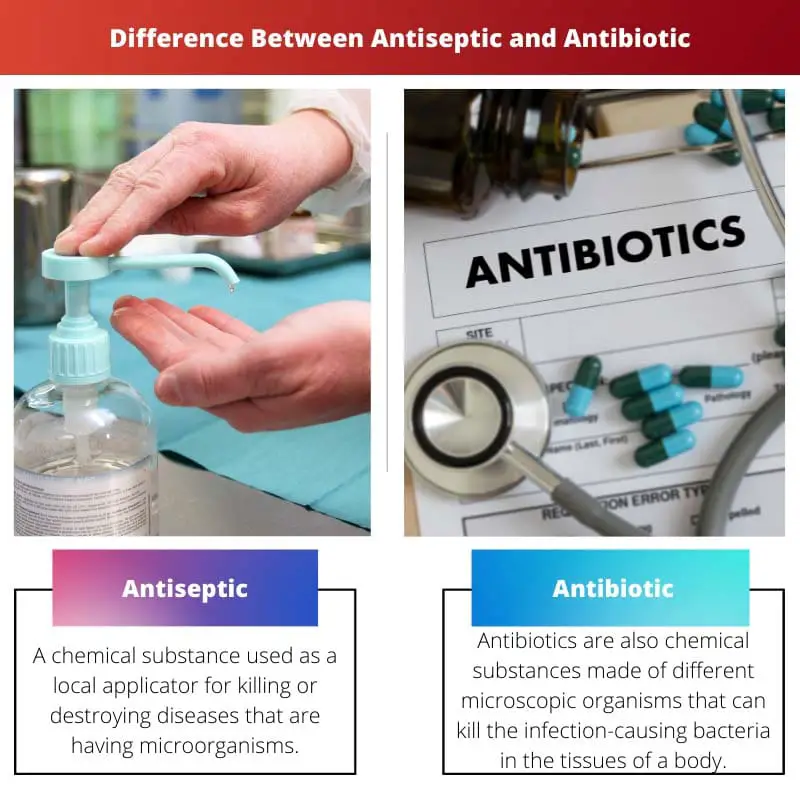Antiseptics and antibiotics are chemical substances and antimicrobials that kill microorganisms like fungi, bacteria, and other pathogens. An anti-bacterial, as the name suggests, kills all bacterial germs, but it is an antibiotic. Antibiotics are known for killing and destroying germs and even preventing them from growing.
An antiseptic hinders the reproduction and development of germs and microorganisms. These germs cause many diseases in the living tissues of the body. Antibiotics are different from antiseptics and other antibiotics that are functioning inside the body. Antibiotics are basically used for the treatment of bacterial diseases.
Key Takeaways
- Antiseptics are used to prevent infections and the growth of microorganisms on the surface of living tissues, whereas antibiotics are used to treat infections caused by bacteria.
- Antiseptics kill or inhibit the growth of microorganisms, while antibiotics destroy the bacteria responsible for the infection.
- Antiseptics are less potent than antibiotics and are used for minor wounds and cuts, while antibiotics are used for more severe infections like pneumonia and urinary tract infections.
Antiseptic vs Antibiotic
The difference between antiseptic and antibiotic is that antiseptic slows down the growth and increase of the germs and other microorganisms and prevents them from causing any infection in the tissues, while antibiotic simply kills and destroys the germs and other parasites present in the tissues.

An antiseptic hinders the reproduction and development of germs and microorganisms. These germs cause many diseases in the living tissues of the body. Antiseptic is used to target more than just one bacteria and a combination of it, other viral or fungal species altogether.
Antibiotics are different from antiseptics and other antibiotics that are functioning inside the body. Antibiotics are basically used for the treatment of bacterial diseases. Some of the antibiotics are specialized and made for targeting only specific species of bacteria or other parasites. But there are antibiotics that target more than just one bacterial species and target a very wide range of them.
Comparison Table
| Parameters of comparison | Antiseptic | Antibiotic |
|---|---|---|
| Definition | A chemical substance used as a local applicator for killing or destroying diseases that are having microorganisms. | Antibiotics are also chemical substances made of different microscopic organisms that can kill the infection-causing bacteria in the tissues of a body. |
| Area of action | They have multiple areas of action as they can be easily applied anywhere and at any part of the body. | They target a particular area and are applied to that particular area or part of the infected body. |
| Acting mechanism | They are influenced by the life activities of different microscopic organisms critically. | Their mechanisms of action fall under the category of one of the four different mechanisms of action. |
| Natural | Lemon, pineapple, tea tree oil, honey, lavender, aloe, activated charcoal, etc. | Garlic, green tea, oregano oil, cinnamon, turmeric, ginger, etc. |
| Consumption | They cannot be ingested or swallowed like a pill. | They can be swallowed like a pill or can be ingested too. |
What is Antiseptic?
An antiseptic hinders the reproduction and development of germs and microorganisms. These germs cause many diseases in the living tissues of the body. Antiseptic is used to target more than just one bacteria and a combination of it, other viral or fungal species altogether.
In the nineteenth century, the invention of an antiseptic took place, and then the development went on, today, it is used around the world. Antiseptic can also prevent the growth and development of bacteria and other germs, although it is known for carrying them out of the tissues.
Some of the natural antiseptics consumed are lemon, pineapple, tea tree oil, honey, lavender, aloe, activated charcoal, etc. They are influenced by the life activities of different microscopic organisms critically.

What is Antibiotic?
Antibiotics are different from antiseptics and other antibiotics that are functioning inside the body. Antibiotics are basically used for the treatment of bacterial diseases. Some of the antibiotics are specialized and made for targeting only specific species of bacteria or other parasites. But some antibiotics target more than just one bacterial species and target a very wide range of them.
There are basically two most important methods in which an antibiotic can kill or destroy bacteria. One is they hinder the growth and further multiplication of the bacteria, and the other is they immediately kill the bacteria that is causing the infection.
Most antibiotics are used in patients before any surgery. This ensures that any bacteria or pathogens do not enter the patient’s body from the open wound as the wound stays open for a period of time during the surgery.

Main Differences Between Antiseptic and Antibiotic
- The main difference between antiseptic and antibiotic is that antiseptic slows down the growth and increase of the germs and other microorganisms and prevents them from causing any infection in the tissues, while antibiotic simply kills and destroys the germs and other parasites present in the tissues.
- Antiseptic has multiple areas of action as they can be easily applied anywhere and at any part of the body, while antibiotics target a particular area and are applied at that particular area or part of the body that is infected.
- Antiseptic is influenced by the life activities of different microscopic organisms critically, while mechanisms of action of antibiotics fall under the category of one of the four different mechanisms of action.
- Some natural antiseptics are- Lemon, pineapple, tea tree oil, honey, lavender, aloe, activated charcoal, etc., and natural antibiotics are- Garlic, green tea, oregano oil, cinnamon, turmeric, ginger, etc.
- Antiseptics cannot be ingested or swallowed like a pill, but antibiotics can be swallowed like a pill or can be ingested too.




